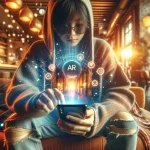

Immersion, i.e. the complete immersion in the virtual reality (VR)represents a groundbreaking aspect of modern technology. The combination of high-resolution graphics, sensitive controls and comprehensive spatial sound succeeds in creating a convincing, realistic experience. These advanced technologies, coupled with innovative design, allow users to transcend the boundaries of the physical world and immerse themselves in immersive virtual worlds.
A key component of VR immersion is multisensory stimulation. In addition to visual and auditory stimulation, which is realized through high-resolution graphics and dynamic 3D sound, modern VR systems are increasingly able to integrate haptic feedback and, in rare cases, smell simulations. This expansion of the sensory experience plays a decisive role in involving users even more deeply in the virtual world and thus creating an even more intense immersion.
Hand and eye tracking: Hand tracking enables users to intuitively grasp, move or manipulate objects with their own hands - without a controller. Eye tracking captures eye movements and dynamically adapts content, e.g. through foveated rendering or realistic eye movements of avatars. This makes the VR experience more natural and immersive.
Haptic feedback: Specialized devices such as haptic gloves and full-body suits provide physical feedback. Users can feel virtual textures, vibrations or even temperature differences, which makes interactions more realistic and increases immersion.
Social VR experiences: Multi-user platforms such as VRChat or Horizon Worlds enable users to explore virtual spaces together. Such social interactions promote teamwork, shared experiences and create emotional bonds within the virtual world.
Adaptive content through AI: Artificial intelligence analyzes user behaviour and dynamically adapts the environment or tasks. This creates individual, challenging and exciting experiences that are tailored to the user's preferences.
The psychological effects of immersion in VR are complex and significant. Users who lose themselves in a virtual environment often experience a strong sense of presence, which can even be used therapeutically, for example in the treatment of phobias or post-traumatic stress disorder (PTSD). These intense experiences can help to confront and overcome real fears by simulating them in a safe, controllable environment.
Exemplary immersive experiences are offered by VR platforms such as HTC Vive, Pico VR and Meta Quest. They are characterized by excellent graphics, immersive sound and intuitive control systems that involve users directly in the action. In the gaming sector, the game "Half-Life: Alyx" in particular has set new standards for immersive VR experiences by offering unprecedented interactivity and realism.
Although immersion in VR offers many advantages, there are also critical aspects to consider. Some users report the so-called VR diseasea form of dizziness and nausea that can be caused by the discrepancy between visual perception and physical sensation. There are also concerns about the long-term psychological effects of intensive VR use. It is therefore crucial to use this technology consciously and responsibly.
Immersion in VR offers a fascinating insight into the future of technology and its potential. It illustrates how far technological development has already progressed and opens the door to new, previously unimaginable possibilities for interaction and experience.

Are you interested in developing a virtual reality or 360° application? You may still have questions about budget and implementation. Feel free to contact me.
I am looking forward to you
Clarence Dadson CEO Design4real






